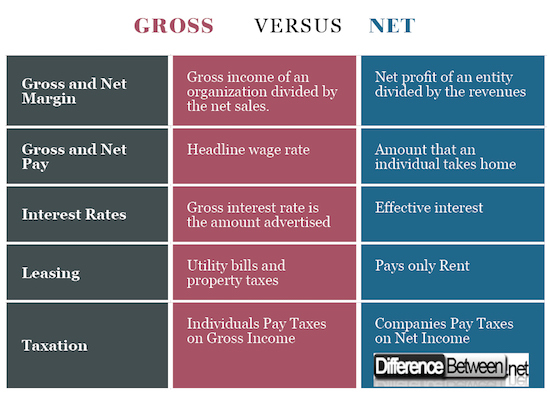Difference Between Net and Gross
The words gross and net are used in the business environment and business operations where they are used to refer to a specific amount of money earned by an organization.
What is gross?
The term gross is used to refer to the earnings earned by a business organization over a defined period, which can be a month or a year without deducting anything from that amount.
For example, a salaried person receives gross income as payment from the employer before statutory deductions such as taxes, contributions to health insurance, and contributions to social security contributions have been made.
In a business environment, the term gross will be used to refer to the amount earned after multiplying the units sold by the business and the price of each unit.
What is net?
The term net is used to refer to the proportion of the total. For example, the total earnings of a business which are realized after selling goods and services minus all associated expenses in a specific period results to the net income of the organization.
Total sales-Expenses Incurred=Net Income
Examples of the expenses incurred by the organization which is deducted from total sales include salaries, utility charges, legal charges, and advertisement charges among others.
Difference between Net and Gross
Meaning of Net and Gross
The term gross is highly used to refer to the total amount made by an organization after performing various activities such as selling of goods and services. For example, total sales and total profits are sometimes referred to as gross sales and gross profits respectively.
The term net is commonly used to define the amount that remains after deducting statutory deductions. For example, salaries and utility charges are deducted from the earnings of the business to give net income.
Net and Gross in Profits
Gross profits refer to the amount at the disposal of an organization which is realized after calculating the difference between the revenues of the organization and the cost of making goods or providing services in an organization.
On the other hand, net profit is the amount that is realized by the organization after deducting all the costs associated with the operations of an entity. Net profits are used to measure the profitability of the business and are recorded in the profit and loss account statement.
Net and Gross in Taxation
Taxes refers to the statutory amounts that individuals and organizations pay to the government in every financial period. Individuals pay taxes (Income tax) to the government on their gross income. This means that taxes are deducted before other expenses have been deducted.
On the other hand, business enterprises and self-employed individuals pay taxes to the taxing authority on their net income. This procedure is highlighted in the tax act of any country.
Net and Gross in Leasing
Leasing refers to the process through which the owner of the property allows an individual to use the property after which the person will be required to pay an agreed monthly or annual payments.
In leasing, a gross lease occurs where the tenant is required to pay for utility bills and property taxes. Some of the other charges paid by the tenant in a total lease include maintenance and upkeep, insurance of the property, water and sewer, and property taxes.
On the other hand, net lease occurs when the tenant is required to pay rent while other charges which include maintenance, taxes, property insurance, and utility charges are paid by the owner of the properties.
Net and Gross in Interest Rates
Interest is the amount that an individual is charged above the principle after acquiring loans from a lending institution, preferable a banking entity.
The gross interest rate is the amount advertised by the organization as the headline upon which individuals will be charged with acquiring loans.
On the other hand, the net interest rate is the effective interest that an individual will be charged after taxes and other statutory charges have been deducted or adjusted from the gross pay. Net interest is the rate at which one will be credited to your account after borrowing money from a credit institution.
Gross and Net Pay
Gross pay is the headline wage rate that an individual receives before both statutory deductions and personal contributions have been made. It is the figure that headlines the individual income before any manipulation is done.
Net pay represents the amount that an individual takes home after all the statutory deductions and personal contributions have been deducted. Some of the deductions deducted from gross pay to form net pay include income tax, insurance, and professional indemnity among others.
Gross and Net Margin
Gross margin is the gross income of an organization divided by the net sales of the company, which is usually expressed as a percentage. Gross margin reveals the profitability of the business enterprises.
Net margin is the net profit of an entity divided by the revenues of an organization which is expressed as a percentage. Net margin reveals how a company is effective in controlling the cost of the company.
Difference between Net and Gross
Summary of Net vs. Gross
- The term gross is used to refer to the total amount earned by an organization before deducting any associated expenses while the term net is used to refer to the amount obtained by the company after deducted all the related costs.
- Gross profit is the amount earned by the company after deducting the direct costs while the net benefit is the amount realized after deducting all expenses.
- Gross leasing is a type of lease where the tenant is required to pay rent, insurance charges, utilities, and property taxes among others while the net lease is a type of contract where the occupant is required to pay rent only.
- Other differences include gross and net interests, total and lost pay, and taxation treatment among other differences.
- Difference Between Gross NPA and Net NPA - April 20, 2018
- Difference Between Job Description and Job Specification - April 13, 2018
- Difference Between Yoga and Power Yoga - April 10, 2018
Search DifferenceBetween.net :
Leave a Response
References :
[0]Kenyon, George, Cem Canel, and Brian D. Neureuther. "The impact of lot-sizing on net profits and cycle times in then-job, m-machine job shop with both discrete and batch processing." International Journal of Production Economics 97.3 (2005): 263-278.
[1]Lin, Ji-Chai. "Order persistence, adverse selection, and gross profits earned by NYSE specialists." Journal of Finance. Vol. 48. No. 3. 44 west fourth st, step 9-190, New York, NY 10012: Amer finance Assn, 1993.
[2]Ryan, Stephen G., et al. "Evaluation of the lease accounting proposed in G4+ 1 special report." Accounting Horizons 15.3 (2001): 289-298.
[3]Image credit: https://c.pxhere.com/photos/a2/e4/calculator_business_office_accounting_finance_close_up_financial_money-714533.jpg!d
[4]Image credit: https://c.pxhere.com/photos/2a/ba/euro_bank_notes_coins_european_currency_business_trade_finance_profit-1052810.jpg!d



